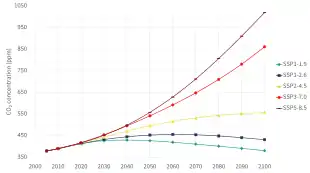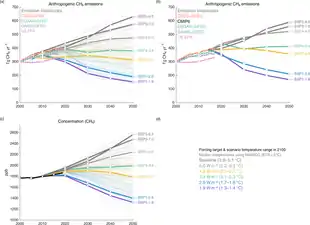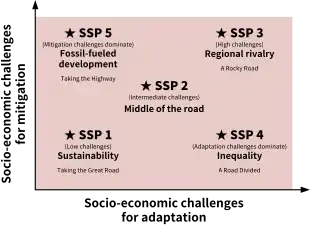Shared Socioeconomic Pathways
Shared Socioeconomic Pathways (SSPs) are scenarios of projected socioeconomic global changes up to 2100. They are used to derive greenhouse gas emissions scenarios with different climate policies.[1]



The scenarios are:
- SSP1: Sustainability (Taking the Green Road)
- SSP2: Middle of the Road
- SSP3: Regional Rivalry (A Rocky Road)
- SSP4: Inequality (A Road divided)
- SSP5: Fossil-fueled Development (Taking the Highway) [4]
They will be used to help produce the IPCC Sixth Assessment Report on climate change, due in 2021.
The SSPs provide narratives describing alternative socio-economic developments. These storylines are a qualitative description of logic relating elements of the narratives to each other.[1] In terms of quantitative elements, they provide data accompanying the scenarios on national population, urbanization and GDP (per capita).[5] The SSPs can be combined with various Integrated Assessment Models (IAMs), to explore possible future pathways both with regards to socioeconomic and climate pathways.[5]
SSP1: Sustainability (Taking the Green Road)
The world shifts gradually, but pervasively, toward a more sustainable path, emphasizing more inclusive development that respects perceived environmental boundaries. Management of the global commons slowly improves, educational and health investments accelerate the demographic transition, and the emphasis on economic growth shifts toward a broader emphasis on human well-being. Driven by an increasing commitment to achieving development goals, inequality is reduced both across and within countries. Consumption is oriented toward low material growth and lower resource and energy intensity.[6][7]
SSP2: Middle of the road
The world follows a path in which social, economic, and technological trends do not shift markedly from historical patterns. Development and income growth proceeds unevenly, with some countries making relatively good progress while others fall short of expectations. Global and national institutions work toward but make slow progress in achieving sustainable development goals. Environmental systems experience degradation, although there are some improvements and overall the intensity of resource and energy use declines. Global population growth is moderate and levels off in the second half of the century. Income inequality persists or improves only slowly and challenges to reducing vulnerability to societal and environmental changes remain.[6][8]
SSP3: Regional rivalry (A Rocky Road)
A resurgent nationalism, concerns about competitiveness and security, and regional conflicts push countries to increasingly focus on domestic or, at most, regional issues. Policies shift over time to become increasingly oriented toward national and regional security issues. Countries focus on achieving energy and food security goals within their own regions at the expense of broader-based development. Investments in education and technological development decline. Economic development is slow, consumption is material-intensive, and inequalities persist or worsen over time. Population growth is low in industrialized and high in developing countries. A low international priority for addressing environmental concerns leads to strong environmental degradation in some regions.[6][9]
SSP4: Inequality (A Road Divided)
Highly unequal investments in human capital, combined with increasing disparities in economic opportunity and political power, lead to increasing inequalities and stratification both across and within countries. Over time, a gap widens between an internationally-connected society that contributes to knowledge- and capital-intensive sectors of the global economy, and a fragmented collection of lower-income, poorly educated societies that work in a labor intensive, low-tech economy. Social cohesion degrades and conflict and unrest become increasingly common. Technology development is high in the high-tech economy and sectors. The globally connected energy sector diversifies, with investments in both carbon-intensive fuels like coal and unconventional oil, but also low-carbon energy sources. Environmental policies focus on local issues around middle and high income areas.[6][10]
SSP5: Fossil-Fueled Development (Taking the Highway)
This world places increasing faith in competitive markets, innovation and participatory societies to produce rapid technological progress and development of human capital as the path to sustainable development. Global markets are increasingly integrated. There are also strong investments in health, education, and institutions to enhance human and social capital. At the same time, the push for economic and social development is coupled with the exploitation of abundant fossil fuel resources and the adoption of resource and energy intensive lifestyles around the world. All these factors lead to rapid growth of the global economy, while global population peaks and declines in the 21st century. Local environmental problems like air pollution are successfully managed. There is faith in the ability to effectively manage social and ecological systems, including by geo-engineering if necessary.[6][11]
Projected implications of scenarios
A 2020 study projects that regions inhabited by a third of the human population could become as hot as the hottest parts of the Sahara within 50 years without a change in patterns of population growth and without migration, unless greenhouse gas emissions are reduced. The projected annual average temperature of above 29 °C for these regions would be outside the "human temperature niche" – a suggested range for climate biologically suitable for humans based on historical data of mean annual temperatures (MAT) experienced by populations of varying densities per MAT since ~6,000 ya worldwide – and the most affected regions have little adaptive capacity as of 2020.[12][13][14][15] The following matrix shows their projections for sizes of populations outside the "human temperature niche" – which therefore may potentially seek to emigrate out of their regions – in different climate change scenarios and contemporary projections of population growth for 2070:[16]
| Demographic scenario (SSPs) | World population growth (billion) | World population (billion) | Climate scenario | ||
|---|---|---|---|---|---|
| RCP 2.6 | RCP 4.5 | RCP 8.5 | |||
| mean projected global temperature rise of ~1.5 °C | - | mean projected global temperature rise of ~3.2 °C | |||
| Outside "human climate niche" (bn) | Outside "human climate niche" (bn) | Outside "human climate niche" (bn) | |||
| Zero growth | 0.00 | 7.26 | 1.06 ± 0.30 | 1.62 ± 0.42 | 2.37 ± 0.43 |
| SSP1 | 0.98 | 8.24 | 1.20 ± 0.34 | 1.84 ± 0.48 | 2.69 ± 0.49 |
| SSP2 | 2.20 | 9.46 | 1.38 ± 0.39 | 2.12 ± 0.55 | 3.09 ± 0.56 |
| SSP3 | 3.88 | 11.14 | 1.63 ± 0.46 | 2.49 ± 0.65 | 3.64 ± 0.66 |
| SSP4 | 2.20 | 9.46 | 1.38 ± 0.39 | 2.12 ± 0.55 | 3.09 ± 0.56 |
| SSP5 | 1.21 | 8.47 | 1.24 ± 0.35 | 1.89 ± 0.49 | 2.76 ± 0.50 |
References
- UNECE, 15 May 2019.
- SSP Database (Shared Socioeconomic Pathways) - Version 2.0 https://tntcat.iiasa.ac.at/SspDb/
- Saunois, Marielle; Stavert, Ann R.; Poulter, Ben; Bousquet, Philippe; Canadell, Josep G.; Jackson, Robert B.; Raymond, Peter A.; Dlugokencky, Edward J.; Houweling, Sander; Patra, Prabir K.; Ciais, Philippe; Arora, Vivek K.; Bastviken, David; Bergamaschi, Peter; Blake, Donald R.; Brailsford, Gordon; Bruhwiler, Lori; Carlson, Kimberly M.; Carrol, Mark; Castaldi, Simona; Chandra, Naveen; Crevoisier, Cyril; Crill, Patrick M.; Covey, Kristofer; Curry, Charles L.; Etiope, Giuseppe; Frankenberg, Christian; Gedney, Nicola; Hegglin, Michaela I.; et al. (15 July 2020). "The Global Methane Budget 2000–2017". Earth System Science Data. 12 (3): 1561–1623. Bibcode:2020ESSD...12.1561S. doi:10.5194/essd-12-1561-2020. ISSN 1866-3508. Retrieved 28 August 2020.
- Carbon Brief, 19 April 2018.
- "SSP Database". tntcat.iiasa.ac.at. Retrieved 2019-11-09.
- Riahi, Keywan; van Vuuren, Detlef P.; Kriegler, Elmar; Edmonds, Jae; O’Neill, Brian C.; Fujimori, Shinichiro; Bauer, Nico; Calvin, Katherine; Dellink, Rob; Fricko, Oliver; Lutz, Wolfgang (2017-01-01). "The Shared Socioeconomic Pathways and their energy, land use, and greenhouse gas emissions implications: An overview". Global Environmental Change. 42: 153–168. doi:10.1016/j.gloenvcha.2016.05.009. ISSN 0959-3780.
- van Vuuren, Detlef P.; Stehfest, Elke; Gernaat, David E. H. J.; Doelman, Jonathan C.; van den Berg, Maarten; Harmsen, Mathijs; de Boer, Harmen Sytze; Bouwman, Lex F.; Daioglou, Vassilis; Edelenbosch, Oreane Y.; Girod, Bastien (2017-01-01). "Energy, land-use and greenhouse gas emissions trajectories under a green growth paradigm". Global Environmental Change. 42: 237–250. doi:10.1016/j.gloenvcha.2016.05.008. ISSN 0959-3780.
- Fricko, Oliver; Havlik, Petr; Rogelj, Joeri; Klimont, Zbigniew; Gusti, Mykola; Johnson, Nils; Kolp, Peter; Strubegger, Manfred; Valin, Hugo; Amann, Markus; Ermolieva, Tatiana (2017-01-01). "The marker quantification of the Shared Socioeconomic Pathway 2: A middle-of-the-road scenario for the 21st century". Global Environmental Change. 42: 251–267. doi:10.1016/j.gloenvcha.2016.06.004. ISSN 0959-3780.
- Fujimori, Shinichiro; Hasegawa, Tomoko; Masui, Toshihiko; Takahashi, Kiyoshi; Herran, Diego Silva; Dai, Hancheng; Hijioka, Yasuaki; Kainuma, Mikiko (2017-01-01). "SSP3: AIM implementation of Shared Socioeconomic Pathways". Global Environmental Change. 42: 268–283. doi:10.1016/j.gloenvcha.2016.06.009. ISSN 0959-3780.
- Calvin, Katherine; Bond-Lamberty, Ben; Clarke, Leon; Edmonds, James; Eom, Jiyong; Hartin, Corinne; Kim, Sonny; Kyle, Page; Link, Robert; Moss, Richard; McJeon, Haewon (2017-01-01). "The SSP4: A world of deepening inequality". Global Environmental Change. 42: 284–296. doi:10.1016/j.gloenvcha.2016.06.010. ISSN 0959-3780.
- Kriegler, Elmar; Bauer, Nico; Popp, Alexander; Humpenöder, Florian; Leimbach, Marian; Strefler, Jessica; Baumstark, Lavinia; Bodirsky, Benjamin Leon; Hilaire, Jérôme; Klein, David; Mouratiadou, Ioanna (2017-01-01). "Fossil-fueled development (SSP5): An energy and resource intensive scenario for the 21st century". Global Environmental Change. 42: 297–315. doi:10.1016/j.gloenvcha.2016.05.015. ISSN 0959-3780.
- "Climate change: More than 3bn could live in extreme heat by 2070". BBC News. 5 May 2020. Retrieved 6 May 2020.
- "'Near-unlivable' heat for one-third of humans within 50 years if greenhouse gas emissions are not cut". University of Exeter. 4 May 2020. Retrieved 6 May 2020.
- "Billions projected to suffer nearly unlivable heat in 2070". Phys.org. 4 May 2020. Retrieved 6 May 2020.
- Xu, Chi; Kohler, Timothy A.; Lenton, Timothy M.; Svenning, Jens-Christian; Scheffer, Marten (26 May 2020). "Future of the human climate niche – Supplementary Materials". Proceedings of the National Academy of Sciences. 117 (21): 11350–11355. doi:10.1073/pnas.1910114117. ISSN 0027-8424. PMC 7260949. PMID 32366654.
- "Future of the human climate niche" (PDF). Retrieved 25 June 2020.
Sources
- "Shared Socioeconomic Pathways (SSPs)" (PDF).
- Meinshausen, Malte (2019). "Implications of the Developed Scenarios for Climate Change". In Teske, Sven (ed.). Achieving the Paris Climate Agreement Goals. Achieving the Paris Climate Agreement Goals: Global and Regional 100% Renewable Energy Scenarios with Non-energy GHG Pathways for +1.5°C and +2°C. Springer International Publishing. pp. 459–469. doi:10.1007/978-3-030-05843-2_12. ISBN 9783030058432.CS1 maint: ref=harv (link)
- Hausfather, Zeke (2018-04-19). "Explainer: How 'Shared Socioeconomic Pathways' explore future climate change". Carbon Brief. Retrieved 2019-09-13.
- Riahi et al., The Shared Socioeconomic Pathways and their energy, land use, and greenhouse gas emissions implications: An overview. Global Environmental Change, 42, 153-168. doi:10.1016/j.gloenvcha.2016.05.009